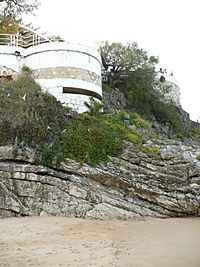Battle of Santander facts for kids
Quick facts for kids Battle of Santander |
|||||||
|---|---|---|---|---|---|---|---|
| Part of the Spanish Civil War | |||||||
 Machine gun nest in Santander. |
|||||||
|
|||||||
| Belligerents | |||||||
|
|
|||||||
| Commanders and leaders | |||||||
| Strength | |||||||
| 80,000 50 artillery batteries 44 aircraft |
90,000 (25,000 Italians) 126 guns 220 aircraft |
||||||
| Casualties and losses | |||||||
| 60,000 captured | Nationalist: 30,000 casualties Italian: 486 killed 1,546 wounded 1 missing |
||||||
The Battle of Santander was a major fight during the Spanish Civil War in the summer of 1937. It was part of a larger campaign called the War in the North. This battle led to the Nationalist forces taking control of the province of Santander, which is now known as Cantabria.
When Santander fell on August 26, it caused huge damage to the Republic's "Army of the North." About 60,000 Republican soldiers were captured by the Nationalists during this battle.
Contents
Why the Battle Happened
After the city of Bilbao fell on June 19, and a Republican attack at Brunete failed on July 25, the Nationalists decided to keep pushing their attack in northern Spain. Their goal was to take over the Cantabria Province.
Who Fought in the Battle
Nationalist Forces
The Nationalist "Army of the North" had about 90,000 soldiers. About 25,000 of these soldiers were from Italy. General Davila led the overall Nationalist forces.
The Italian soldiers were led by General Bastico. They included several divisions, like the Littorio Division and the Black Flames Division. The Nationalists also had six brigades from Navarre, two brigades from Castile, and a mixed Spanish-Italian division called the Black Arrows.
The Nationalists had a big advantage in the air. They had 220 modern aircraft. This included planes from the Condor Legion (German planes) and the Aviazione Legionaria (Italian planes). Many of their planes were fast Bf 109 fighters.
Republican Forces
The Republican side had about 80,000 soldiers. These were divided into two main groups, the 14th Army Corps and the 15th Army Corps. General Mariano Gámir Ulíbarri was in charge of all Republican forces.
The Republicans had far fewer aircraft, only 44 planes. Most of these planes were old and slow, except for 18 Soviet-built fighter planes. The Republican soldiers also had low morale, meaning they weren't feeling very hopeful. Some Basque soldiers even thought about surrendering to the Italians to save their lives.
Key Moments of the Battle
The Battle of Santander lasted from August 14 to September 17, 1937. Here are some of the important events:
- August 14: Nationalist forces began their attack. They aimed to cut off Republican soldiers in the southern Cantabrian Mountains.
- August 15-16: Nationalists advanced, taking important areas like Portillo de Suano and the factories near Reinosa. They entered Reinosa by nightfall on the 16th. Italian forces also pushed forward.
- August 17: Italian forces captured El Escudo Pass. This led to 22 Republican groups being surrounded in Campoo.
- August 18-19: Nationalist and Italian forces continued to advance, taking more towns and valleys like Santiurde, San Pedro del Romeral, and Bárcena de Pie de Concha.
- August 20-22: The Nationalists moved closer to key towns like Torrelavega and Villacarriedo, taking several areas.
- August 23: Nationalist forces reached Mount Ibio, almost cutting off the main road and railway between Santander and Asturias.
- August 24: General Gámir-Ulibarri ordered a full retreat towards Asturias. The Nationalists captured Torrelavega and Barreda, blocking the main road to Asturias. Some Basque forces signed the Santoña Agreement, choosing to surrender to the Italians.
- August 25: The main Republican leaders left Santander and headed to Gijón in Asturias.
- August 26: Nationalist forces entered Santander around noon. Many Republican soldiers were captured.
- September 1: The Nationalists took Unquera, a town on the border with Asturias.
- September 17: Tresviso, the last part of Cantabria still held by Republicans, fell to the Nationalists.
What Happened After the Battle
The fall of Santander, along with the earlier capture of Bilbao, created a huge gap in the Republic's northern defenses. The defeat of the "Army of the North" was a major setback for the Republic and helped Franco's Nationalist side gain a strong advantage in the war.
Several reasons contributed to the Republican defeat:
- The Nationalists had much more artillery and air power.
- The Republican units from Asturia, Cantabria, and Basque regions did not work well together under one command.
- The Nationalist attack was very fast and precise, aiming to destroy enemy forces rather than just taking land.
- The Republican soldiers had low morale, while the Nationalists were very confident and enthusiastic.
- Some Basque units in the Republican army chose to surrender, as seen in the Santoña Agreement.
The losses for the Republic were huge and hard to recover from. Many brigades were almost completely destroyed. About 60,000 Republican soldiers were removed from the fight, along with a lot of their equipment. This battle meant that the "War in the North" was almost completely won by the Nationalists.
See also
 In Spanish: Batalla de Santander para niños
In Spanish: Batalla de Santander para niños
- List of Spanish Nationalist military equipment of the Spanish Civil War
- List of weapons of the Corpo Truppe Volontarie
- Condor Legion
- List of Spanish Republican military equipment of the Spanish Civil War

